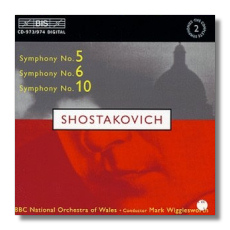
The Internet's Premier Classical Music Source
Related Links
- Shostakovich Reviews
- Latest Reviews
- More Reviews
-
By Composer
-
Collections
DVD & Blu-ray
Books
Concert Reviews
Articles/Interviews
Software
Audio
Search Amazon
Recommended Links
Site News
 CD Review
CD Review
Dmitri Shostakovich

Symphonies, Volume 2
- Symphony #5 in D minor, Op. 47 (1937)
- Symphony #6 in B minor, Op. 54 (1939)
- Symphony #10 in E minor, Op. 93 (1953)
BBC National Orchestra of Wales/Mark Wigglesworth
BIS CD 973/4 DDD 2CDs 76:38, 63:31
This is the second installment in Wigglesworth's projected series of the complete Shostakovich symphonies. The "Leningrad" Symphony was released about two years ago. I thought it was an excellent reading of this difficult score; Wigglesworth conducted it with intensity and imagination, and the Welsh orchestra played it fearlessly, if not always smoothly.
If that first installment was uncommonly good, the second one is just plain uncommon, although the more I hear it, the more I like it. The qualities that served Wigglesworth's "Leningrad" so well return on this pair of discs, almost to the point of exaggeration. I have never heard such extreme readings of these works; this is chamber of horrors Shostakovich – not necessarily a bad thing, but don't say I didn't warn you! Wigglesworth conducts with epic fatalism, leaving very little doubt as to how he reads the meaning of these very personal symphonies. (In case you still miss the point, then you can read his annotations!) I might try to sum this meaning up in three words: anguish, fear, and death. The conductor's tempos are record-breakingly slow. The timing for the opening movement of the Fifth Symphony is 19:29 (most conductors take 15 or 16 minutes), and the timing for the equivalent movement of the Tenth is 25:52. I would call this Brucknerian Shostakovich, except for the fact that the Austrian composer was a devout Christian, and God clearly has packed up and gone for good from Shostakovich's musical world.
Nevertheless, there is much to like here, if "like" really is quite the right word! Take the coda of the Fifth's first movement, where the violins' and violas' upward glissando is like the finger of Death drawing a peephole in the condensation on a cold window pane. Wigglesworth gets the terraced tempo increases right in the same work's finale, and for once the closing moments are done in tempo, with no egregious slowing for effect. The bearish waltz of the Allegretto is grotesquely attenuated, making it sound even more Mahlerian than usual. Other excellent touches include the voicing of the woodwinds' ascending figure at the end of the Sixth's Allegro, and the bite of the strings in the following movement. Wigglesworth's creative phrasings repeatedly mold the music into shapes I hadn't thought of prior to hearing this recording.
Weak points? The conductor's fondess for extreme pianissimos may irritate many (but just try the ending of the Sixth's Largo!), and the low brass occasionally are overpowered, particularly in the Tenth's third movement. At times the BBC National Orchestra of Wales seems to be hanging on for dear life; along with the many felicitous instrumental details there are a few awkward moments of discomfort.
Wigglesworth's highly personal Shostakovich must be heard (not necessarily enjoyed) by everyone who values this composer. BIS includes an essay from the conductor that shows just how committed he is. The sound on these discs is sensational, except for the backwardly balanced low brass, as mentioned above.
Copyright © 1999, Raymond Tuttle


















